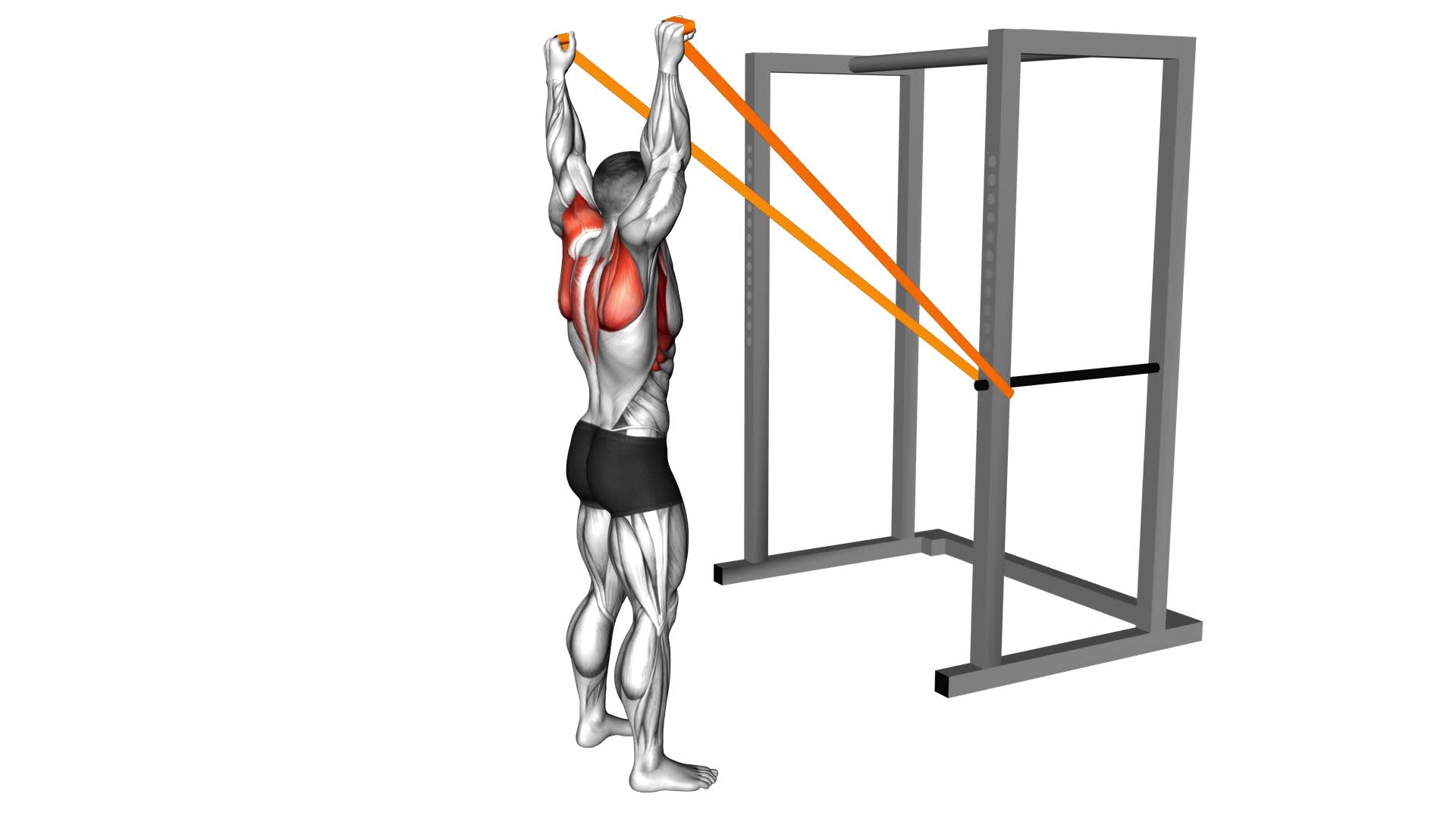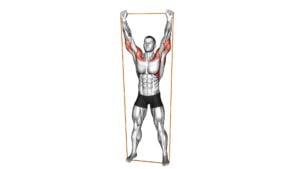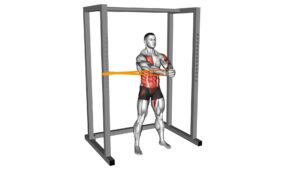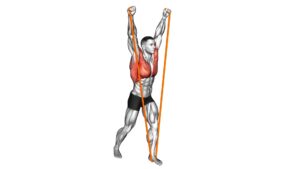Resistance Band Y Press (male) – Video Exercise Guide & Tips

Are you looking for a challenging and effective upper body exercise? The Resistance Band Y Press is a great option for you.
Watch This Exercise Video
This exercise targets your shoulders, back, and arms, helping you build strength and improve posture.
In this video exercise guide, we'll show you the proper form and technique, as well as provide tips to avoid common mistakes and injuries.
Get ready to level up your workout routine with the Resistance Band Y Press!
Key Takeaways
- Resistance Band Y Press targets the shoulders, back, and arms, helping to build strength and improve posture.
- Engaging multiple muscle groups simultaneously, this exercise is time-efficient and effective.
- It also improves shoulder mobility and flexibility.
- Proper form and technique, such as focusing on alignment, engaging the core, and maintaining a full range of motion, are crucial for maximizing the benefits and preventing injuries.
Benefits of the Resistance Band Y Press
Experience the numerous benefits of the Resistance Band Y Press, a highly effective exercise that targets your shoulders, upper back, and core muscles. Incorporating this exercise into your workout routine can bring about significant improvements in strength, stability, and posture.
One of the key benefits of the Resistance Band Y Press is its ability to engage multiple muscle groups simultaneously, making it a time-efficient exercise. By targeting your shoulders, upper back, and core muscles, this exercise helps to improve your overall upper body strength and stability. It also helps to enhance your posture by strengthening the muscles that support a proper alignment of your spine.
In addition to its effectiveness in building strength and stability, the Resistance Band Y Press also aids in improving shoulder mobility and flexibility. By performing this exercise regularly, you can increase the range of motion in your shoulder joints, which is beneficial for various activities and sports.
Proper Form and Technique for the Exercise
To perform the Resistance Band Y Press with proper form and technique, it's important to focus on three key points:
- Alignment and posture: Ensure that your body is aligned and your posture is maintained throughout the exercise to prevent any strain or injury.
- Breathing and core engagement: Remember to engage your core and breathe properly to maximize the effectiveness of the exercise.
- Range of motion: Aim for a full range of motion to activate the targeted muscles and optimize your results.
Alignment and Posture
Maintaining proper alignment and posture is crucial when performing the Resistance Band Y Press exercise. This ensures that you're targeting the correct muscles and minimizing the risk of injuries. Here are some important points to keep in mind:
- Alignment and Posture:
- Stand tall with your feet hip-width apart.
- Engage your core and keep your spine in a neutral position.
- Keep your shoulders down and relaxed.
- Maintain a slight bend in your knees throughout the exercise.
- Common Mistakes and Injuries:
- Arching your back excessively can strain your lower back.
- Shrugging your shoulders can lead to neck and shoulder pain.
- Allowing your knees to collapse inward puts stress on your joints.
Breathing and Core Engagement
To ensure proper form and technique for the Resistance Band Y Press exercise, it's important for you to focus on your breathing and engage your core throughout the movement. Proper breathing techniques will help you maintain stability and control during the exercise.
As you perform the Y Press, exhale as you extend your arms overhead and inhale as you bring them back down. This controlled breathing pattern will help you stabilize your core and maintain proper alignment throughout the movement.
Engaging your core is crucial for maintaining stability and preventing any unnecessary strain on your lower back. Keep your core muscles activated by gently drawing your belly button towards your spine throughout the exercise.
By focusing on your breathing and engaging your core, you'll maximize the effectiveness of the Resistance Band Y Press while minimizing the risk of injury.
Now, let's move on to discussing the range of motion for this exercise.
Range of Motion
Now, let's dive into the range of motion for the Resistance Band Y Press exercise and focus on how to perform it with proper form and technique.
To ensure you're getting the most out of this exercise and improving flexibility while increasing shoulder strength, keep the following in mind:
- Start by standing with your feet shoulder-width apart and holding the resistance band with an overhand grip.
- Begin with your arms extended in front of you at shoulder height, forming a 'Y' shape with the band.
- Slowly raise your arms overhead, maintaining tension in the band and keeping your core engaged.
- Pause for a moment at the top of the movement, then slowly bring your arms back down to the starting position.
By performing the Resistance Band Y Press with the correct range of motion, you'll maximize the benefits of the exercise.
Now, let's move on to choosing the right resistance band for your fitness level.
Choosing the Right Resistance Band for Your Fitness Level
When selecting a resistance band for your workouts, it's important to consider your fitness level. Band strength recommendations can help guide you in choosing the right resistance level that challenges you without causing strain or injury.
As you progress in your fitness journey, remember to customize your resistance levels by using heavier bands to continue challenging your muscles and promoting growth.
Band Strength Recommendations
You should regularly assess your fitness level to determine the appropriate resistance band strength for your workouts. Choosing the right band strength is crucial to ensure that you're challenging yourself enough without risking injury.
Here are some band strength recommendations based on your fitness level:
- Beginner:
- Light resistance bands are suitable for beginners who are new to strength training or have limited strength.
- These bands provide less tension and are easier to control, making them ideal for learning proper form and technique.
- Intermediate/Advanced:
- Medium to heavy resistance bands are recommended for individuals with a moderate to high fitness level.
- These bands offer increased tension, providing a more challenging workout and allowing for muscle growth and strength development.
By selecting the appropriate band strength for your fitness level, you can optimize your workouts and progress at a safe and effective pace.
Now, let's delve into customizing resistance levels to meet your specific needs.
Customizing Resistance Levels
To customize resistance levels for your fitness level, it's essential to choose the appropriate resistance band strength. Customizing resistance levels involves adjusting the band tension to suit your specific needs and abilities.
When selecting a resistance band, consider your current strength and fitness level. If you're a beginner or have limited upper body strength, it's recommended to start with a lighter resistance band. On the other hand, if you're more advanced or have developed strength, a heavier resistance band may be suitable for you.
It's important to find a balance where the resistance challenges you without compromising your form or causing injury. Remember, you can always gradually increase the resistance as your strength improves.
Progressing With Heavier Bands
To effectively progress with heavier bands and choose the appropriate resistance band for your fitness level, it's important to consider your current strength and abilities. Here are some tips to help you with your progression techniques and increasing resistance:
- Start with a band that provides a challenging but manageable level of resistance.
- If the band feels too easy, move up to a heavier resistance band.
- If the band feels too difficult, switch to a lighter resistance band.
Gradually increase the resistance as you become stronger and more comfortable with the exercises. You can achieve this by using thicker bands or adding more bands to create more tension. Listen to your body and make adjustments accordingly to avoid injury.
Variations and Progressions to Challenge Yourself
Challenge yourself with variations and progressions of the Resistance Band Y Press exercise to maximize your strength and endurance. By incorporating different variations, you can target different muscles and add variety to your workout routine.
One variation you can try is the Single-Arm Resistance Band Y Press. This involves performing the exercise with one arm at a time, which requires more stability and engages your core muscles.
Another variation is the Resistance Band Y Press with a squat. In this version, you perform a squat while simultaneously pressing the resistance band overhead in a Y shape. This adds an extra challenge to your lower body and increases the intensity of the exercise.
To further challenge yourself, you can progress to using a heavier resistance band. This will increase the resistance and difficulty of the exercise, helping you build more strength and endurance.
Remember to always maintain proper form and listen to your body. Start with lighter resistance bands and gradually progress to heavier ones as you become more comfortable and confident with the exercise. Push yourself, but always prioritize safety and proper technique.
Tips for Avoiding Common Mistakes and Injuries
Ensure proper form and prevent injuries by maintaining a strong grip on your resistance band throughout the Y Press exercise. This will help you avoid common mistakes and reduce the risk of injury.
Here are some tips to keep in mind:
- Choose the right resistance band: Select a band that provides enough resistance for your strength level, but not so much that it compromises your form or causes strain.
- Warm up before starting: Engage in some dynamic stretching or light cardio to warm up your muscles and prepare them for the exercise.
- Maintain proper posture: Stand tall with your feet shoulder-width apart and your core engaged. Keep your shoulders down and back, avoiding any hunching or rounding of the upper back.
- Avoid using excessive momentum: Focus on controlled movements and avoid jerking or swinging the resistance band. This will help you maintain proper form and prevent strain on your muscles and joints.
- Listen to your body: Pay attention to any discomfort or pain during the exercise. If something doesn't feel right, stop and reassess your form or consult with a fitness professional.
- Gradually increase resistance: As you get stronger, gradually increase the resistance of your band to continue challenging yourself. However, always prioritize maintaining proper form and avoiding injuries over increasing resistance too quickly.
Incorporating the Resistance Band Y Press Into Your Workout Routine
To incorporate the Resistance Band Y Press into your workout routine, start by performing 3 sets of 10 repetitions, gradually increasing the resistance as you get stronger.
The Resistance Band Y Press is a great exercise for targeting your shoulders, upper back, and core muscles. It's a versatile exercise that can be incorporated into your workout routine in several ways.
One way to incorporate resistance bands into your workout routine is by using them as a warm-up exercise before your main workout. Start by attaching the resistance band to a stable anchor point, such as a door handle or a sturdy pole. Stand with your feet shoulder-width apart and hold the resistance band with an overhand grip.
Extend your arms straight out in front of you at shoulder height, forming a Y shape with your body. Then, squeeze your shoulder blades together as you pull the resistance band towards your chest. Pause for a moment and then slowly return to the starting position.
Another way to incorporate the Resistance Band Y Press into your workout routine is by using it as a standalone exercise. You can perform multiple sets and repetitions to target your shoulders and upper back muscles. Remember to maintain proper form throughout the exercise, keeping your core engaged and your back straight.
Incorporating resistance bands into your workout routine can help add variety and challenge to your workouts. The Resistance Band Y Press is a great exercise for targeting the muscles of your upper body and can be easily modified to suit your fitness level. Give it a try and see the benefits for yourself!
Frequently Asked Questions
How Many Repetitions Should I Do When Performing the Resistance Band Y Press?
When performing the resistance band Y press, it's important to focus on proper form. This exercise targets your shoulders and upper back, so it's crucial to maintain proper alignment and control throughout each repetition.
As for the number of repetitions, it's recommended to start with a lighter resistance band and aim for 10-15 reps per set. Gradually increase the intensity as you become more comfortable and stronger.
Incorporating the resistance band Y press into your workout routine can improve your posture and strengthen your upper body.
Can Women Also Perform the Resistance Band Y Press Exercise?
Yes, women can also perform the resistance band Y press exercise. This exercise can be modified to suit women's fitness goals and abilities.
It offers numerous benefits for women, such as strengthening the upper body, improving posture, and targeting the shoulder and back muscles.
The resistance band allows for adjustable resistance levels, making it suitable for all fitness levels.
Incorporating the resistance band Y press into your workout routine can help you achieve your desired fitness results.
Is It Necessary to Warm up Before Doing the Resistance Band Y Press?
Before jumping into the Resistance Band Y Press, it's important to warm up your muscles. Dynamic warm up exercises help increase blood flow and prepare your body for the upcoming workout. Warming up can reduce the risk of injury and improve your performance.
Once you're warmed up, focus on maintaining proper form and technique during the exercise. Keep your core engaged, shoulders down and back, and press the resistance bands up into a Y shape for maximum benefits.
How Long Should I Rest Between Sets of the Resistance Band Y Press?
To optimize your workout, it's important to consider the rest time between sets of the resistance band Y press. Resting between sets allows your muscles to recover and ensures proper form and technique.
The ideal rest time for the resistance band Y press can vary depending on your fitness level and goals. Generally, a rest time of 30-60 seconds between sets is recommended to allow for sufficient recovery while maintaining intensity.
Adjust the number of sets based on your fitness goals and progress.
Can the Resistance Band Y Press Help in Building Muscle Mass?
The Resistance Band Y Press is a great exercise for building muscle mass. It targets the muscles in your shoulders, upper back, and arms.
Compared to the Dumbbell Y Press, the Resistance Band Y Press offers added resistance throughout the entire movement, leading to increased muscle activation and strength gains.
This exercise is particularly beneficial for strength training, as it helps to improve posture, stability, and overall upper body strength.
Incorporating the Resistance Band Y Press into your routine can yield great results.
Conclusion
The Resistance Band Y Press is a versatile exercise that offers numerous benefits, such as strengthening the shoulders, back, and core.
By using proper form and technique, choosing the right resistance band, and incorporating variations and progressions, you can challenge yourself and avoid common mistakes and injuries.
Adding the Resistance Band Y Press to your workout routine can help improve your overall strength and fitness level.
So grab a resistance band and start reaping the benefits of this effective exercise.

Author
Years ago, the spark of my life’s passion ignited in my mind the moment I stepped into the local gym for the first time. The inaugural bead of perspiration, the initial endeavor, the very first surge of endorphins, and a sense of pride that washed over me post-workout marked the beginning of my deep-seated interest in strength sports, fitness, and sports nutrition. This very curiosity blossomed rapidly into a profound fascination, propelling me to earn a Master’s degree in Physical Education from the Academy of Physical Education in Krakow, followed by a Sports Manager diploma from the Jagiellonian University. My journey of growth led me to gain more specialized qualifications, such as being a certified personal trainer with a focus on sports dietetics, a lifeguard, and an instructor for wellness and corrective gymnastics. Theoretical knowledge paired seamlessly with practical experience, reinforcing my belief that the transformation of individuals under my guidance was also a reflection of my personal growth. This belief holds true even today. Each day, I strive to push the boundaries and explore new realms. These realms gently elevate me to greater heights. The unique combination of passion for my field and the continuous quest for growth fuels my drive to break new ground.







